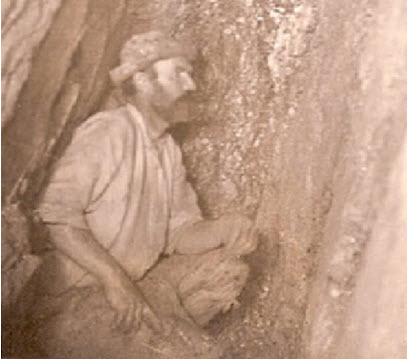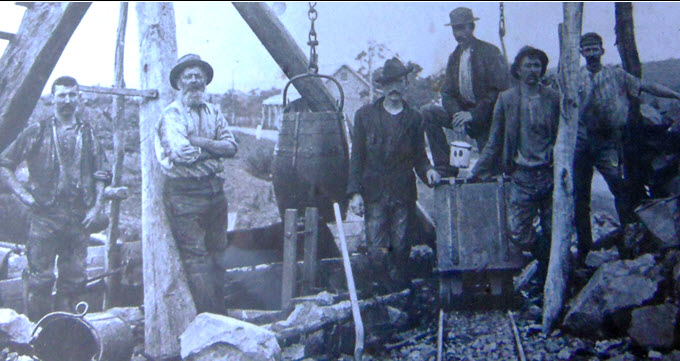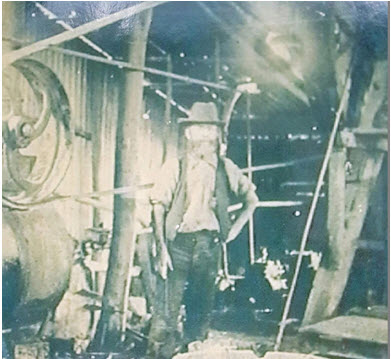5. Webb & Brailey - master & apprentice of the Solitary Mines
During the post-rush renaissance of Wattle Flat (1880-1910) two men stand out as being the driving force behind the Solitary mining project . Their relationship with each other seems like master & apprentice. Robert N Brailey (1847-1915) is 13 years younger than Thomas Webb (1834-1910). Webb learns underground mining in Bendigo, and brings his skillset to Wattle Flat in 1882. Brailey grew up at Solitary, shared his local learning about reefs & machines with W Campbell during the 1860’s & 70’s, & then most likely worked as an apprentice member of Webb’s mining party at Solitary during the 1880’s when the Solitary Reef Gold Mining Company owned the mine.

Both Webb & Brailey would have been frustrated by a slow-down in the general mining industry in the late 1880’s. The government offers some financial assistance to miners at this time with what was called the Prospecting Vote. At Old Solitary, a chemist named Florance (Austral Pyrites Co) is experimenting with fluxes in furnaces & plans a new plant to process the sulphide bearing quartz. There is no underground mining or development.
Webb takes up leases on the Solitary Reef to the north. Here he drains & develops an old shaft. By 1894 he has revealed two rich reefs with a high proportion of sulphides. He acquires a stamp battery from near Surface Hill and sets up a processing plant. This mine becomes known as the Solitary Extended Mine.
In 1894 Brailey establishes his own stamp battery at Old Solitary Mine & over the following years adds the latest gold saving machines to this processing plant. This plant becomes a main-stay for the local reef mining industry for the next ten years.
With the assistance of Sydney businessman, Brailey acquires the Old Solitary Mine in 1895. He gathers a mining team & starts developing a new shaft (image below). Brailey’s team mines & processes significant amounts of quartz from the Old Solitary Mine.

R N Brailey underground c1896

R N Brailey & party at top of his underlay shaft in 1896

R N Brailey at his battery c1896
The success of both Webb & Brailey during the mid 1890’s attracts the attention of mining investors in Sydney & London. In 1896 a new company is floated in London with the name “The Great Victorian Gold Mining Company”, based on acquiring the Solitary mines of Webb & Brailey – “Old Solitary” & “Solitary Extended”.
At exactly this stage in history great advances are being made in the chemical extraction of gold from problematical sulphide bearing ores. These are the chlorination process & the cyanide process. The Great Victorian GMC plans to install the best technology at a renewed Solitary Mine in Wattle Flat.
Webb sells his mine to the company. Brailey initially resists, but after experiencing difficulties in his underlay shaft he too sells to the company.
Prior to investing in a processing plant, the company extend the underground shafts & tunnels to gain confidence in the extent of the resource. They employ both Webb & Brailey to lead mining teams to undertake this work. Webb deepens the main shaft and Brailey establishes a new vertical shaft.
Mining proceeds until 1899, when the company seems to experience a conflict of interests. Great opportunities for mining investment are opening up in Mexico and the company curtails its investment at Solitary.
In 1900, a local mining entrepreneur W E Myring comes to the rescue of the Solitary Mine. Myring & Brailey gain ownership of the Solitary mine & rename it the Roxburgh Mine. Underground mining continues with multiple mining parties operating on a tribute basis. Webb leads one of the tribute mining parties.
In 1904 an investment company buys the interests of the Roxburgh mine allowing the mining parties to continue their work. By 1906, it seems that all is not well, and the miners take the company to court for non-payment of wages.
Over the next few years mining activity at Solitary and other mines in Wattle Flat diminishes. As well as having been very good miners, both Webb & Brailey were active participants in the village social scene, and were often involved in gatherings & concerts as musicians etc. Webb & Brailey, now elderly men with sons & sons in law engaged in the mining industry, take a back seat. Both live out their final years in Wattle Flat.